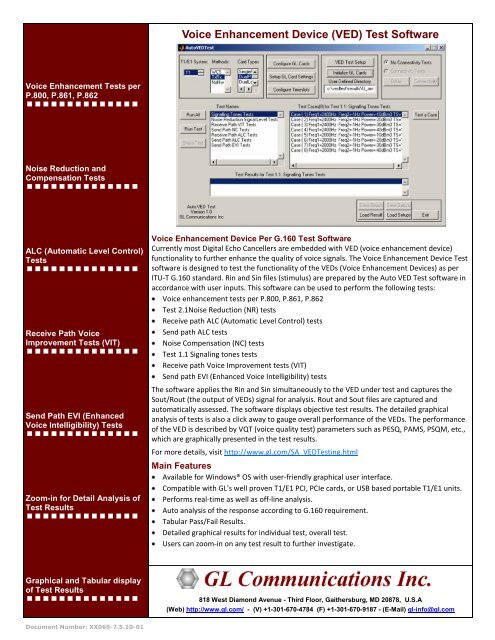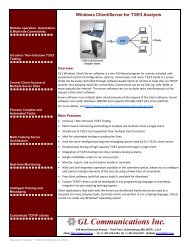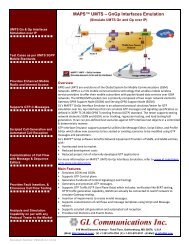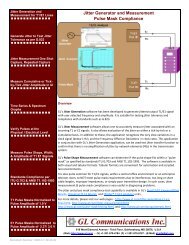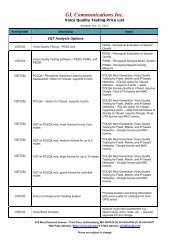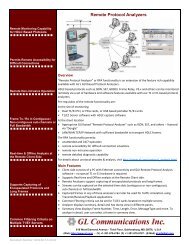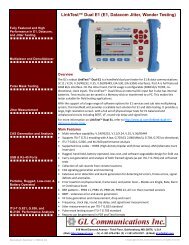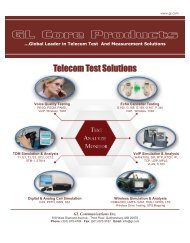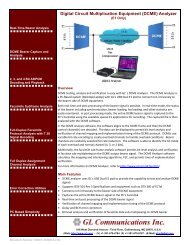Voice Enhancement Device Test Software
Voice Enhancement Device Test Software
Voice Enhancement Device Test Software
Create successful ePaper yourself
Turn your PDF publications into a flip-book with our unique Google optimized e-Paper software.
<strong>Voice</strong> <strong>Enhancement</strong> <strong>Device</strong> (VED) <strong>Test</strong> <strong>Software</strong><br />
<strong>Voice</strong> <strong>Enhancement</strong> <strong>Test</strong>s per<br />
P.800, P.861, P.862<br />
<br />
Noise Reduction and<br />
Compensation <strong>Test</strong>s<br />
<br />
ALC (Automatic Level Control)<br />
<strong>Test</strong>s<br />
<br />
Receive Path <strong>Voice</strong><br />
Improvement <strong>Test</strong>s (VIT)<br />
<br />
Send Path EVI (Enhanced<br />
<strong>Voice</strong> Intelligibility) <strong>Test</strong>s<br />
<br />
Zoom-in for Detail Analysis of<br />
<strong>Test</strong> Results<br />
<br />
<strong>Voice</strong> <strong>Enhancement</strong> <strong>Device</strong> Per G.160 <strong>Test</strong> <strong>Software</strong><br />
Currently most Digital Echo Cancellers are embedded with VED (voice enhancement device)<br />
functionality to further enhance the quality of voice signals. The <strong>Voice</strong> <strong>Enhancement</strong> <strong>Device</strong> <strong>Test</strong><br />
software is designed to test the functionality of the VEDs (<strong>Voice</strong> <strong>Enhancement</strong> <strong>Device</strong>s) as per<br />
ITU-T G.160 standard. Rin and Sin files (stimulus) are prepared by the Auto VED <strong>Test</strong> software in<br />
accordance with user inputs. This software can be used to perform the following tests:<br />
<strong>Voice</strong> enhancement tests per P.800, P.861, P.862<br />
<strong>Test</strong> 2.1Noise Reduction (NR) tests<br />
Receive path ALC (Automatic Level Control) tests<br />
Send path ALC tests<br />
Noise Compensation (NC) tests<br />
<strong>Test</strong> 1.1 Signaling tones tests<br />
Receive path <strong>Voice</strong> Improvement tests (VIT)<br />
Send path EVI (Enhanced <strong>Voice</strong> Intelligibility) tests<br />
The software applies the Rin and Sin simultaneously to the VED under test and captures the<br />
Sout/Rout (the output of VEDs) signal for analysis. Rout and Sout files are captured and<br />
automatically assessed. The software displays objective test results. The detailed graphical<br />
analysis of tests is also a click away to gauge overall performance of the VEDs. The performance<br />
of the VED is described by VQT (voice quality test) parameters such as PESQ, PAMS, PSQM, etc.,<br />
which are graphically presented in the test results.<br />
For more details, visit http://www.gl.com/SA_VED<strong>Test</strong>ing.html<br />
Main Features<br />
Available for Windows® OS with user-friendly graphical user interface.<br />
Compatible with GL's well proven T1/E1 PCI, PCIe cards, or USB based portable T1/E1 units.<br />
Performs real-time as well as off-line analysis.<br />
Auto analysis of the response according to G.160 requirement.<br />
Tabular Pass/Fail Results.<br />
Detailed graphical results for individual test, overall test.<br />
Users can zoom-in on any test result to further investigate.<br />
Graphical and Tabular display<br />
of <strong>Test</strong> Results<br />
<br />
818 West Diamond Avenue - Third Floor, Gaithersburg, MD 20878, U.S.A<br />
(Web) http://www.gl.com/ - (V) +1-301-670-4784 (F) +1-301-670-9187 - (E-Mail) gl-info@gl.com<br />
Document Number: XX069-7.5.10-01
VED <strong>Test</strong> System<br />
The image below provides a graphical representation of the Auto<br />
VED test system. The figure displays 2 GL’s T1/E1 Cards with<br />
digital and analog inputs and outputs. (Alternatively, GL’s USB<br />
based T1/E1 Analyzer unit can be used for convenience and<br />
portability.) Digital inputs and outputs are used to interface T1/<br />
E1 lines of the VED under test with computers.<br />
Page 2<br />
Graphical Analysis of <strong>Test</strong> Results<br />
Noise Reduction Signal Level, and Signaling Tones <strong>Test</strong><br />
Results, with Rout Power in dBmo versus Time in seconds.<br />
Figure: Noise-Reduction-and-Signaling-Level<br />
Figure: VED <strong>Test</strong> System<br />
<strong>Test</strong>s to evaluate <strong>Voice</strong> <strong>Enhancement</strong> <strong>Device</strong>s<br />
Following are the basic tests needed to fully evaluate the<br />
characteristics of voice enhancement devices:<br />
Noise Reduction tests (for the receive path)<br />
These tests are designed in way that two VQT (voice quality tests)<br />
are performed. The NR performance is evaluated by comparing<br />
the VQT 1 score with the VQT 2 score. (Note: VQT1 is the voice<br />
quality test between the reference file, and the degraded file.<br />
Degraded files are obtained by added noise to the reference file.<br />
VQT2 is performed between the Rout (the voice enhancement<br />
devices improved signal) and the reference file.<br />
Noise Compensation tests (for the send path)<br />
These tests are evaluated by the Sout signal power versus the<br />
noise power signals.<br />
Automatic Level Control tests (receive and send paths)<br />
The ALC tests are evaluated by the Sout (or Rout) signal power<br />
versus Sin (or Rin) power levels.<br />
Figure: <strong>Voice</strong> Improvement <strong>Test</strong> Setup<br />
Receive Path VIT Results, with PESQ LQ Score versus Impairing<br />
Signaling Power in dBmo.<br />
Send Path EVI <strong>Test</strong>s Results, with PAMS LE Score versus Noise<br />
Power in dBmo.<br />
Figure: Receive and Send Path<br />
Buyer's guide<br />
XX069 – Automated <strong>Voice</strong> <strong>Enhancement</strong> <strong>Device</strong> <strong>Test</strong> <strong>Software</strong><br />
VQT001 – w/VQT-PAMS and PSQM<br />
VQT003 – w/VQT-PESQ upgrade<br />
Related <strong>Software</strong><br />
XX063 – Echo Path Delay/Loss Measurement <strong>Software</strong><br />
XX067 – Automated Echo Canceller <strong>Test</strong>ing w/o VQT<br />
XX020 – Record/Playback File <strong>Software</strong><br />
XX600 – Basic Client Server Scripted Control <strong>Software</strong><br />
(Included with Basic <strong>Software</strong>)<br />
XX610 – w/Transmit and Receive File Capability<br />
XX630 – w/DSP Capability<br />
VQT006 – <strong>Voice</strong> Quality <strong>Test</strong>ing (POLQA) for VQT<br />
Related Hardware<br />
UTE001 – Portable USB based Dual T1 or E1 Laptop Analyzer<br />
HTE001 – Universal HD T1 or E1 PCI Cards<br />
PTE001 – tProbe Dual T1 E1 Laptop Analyzer<br />
FTE001, ETE001 – Quad and Octal T1 E1 Analyzer Boards<br />
XTE001 – Dual Express (PCIe) T1 E1 Boards<br />
*Specifications and features subject to change without notice.<br />
818 West Diamond Avenue - Third Floor, Gaithersburg, MD 20878, U.S.A<br />
(Web) http://www.gl.com/ - (V) +1-301-670-4784 (F) +1-301-670-9187 - (E-Mail) gl-info@gl.com<br />
Document Number: XX069-7.5.10-01


